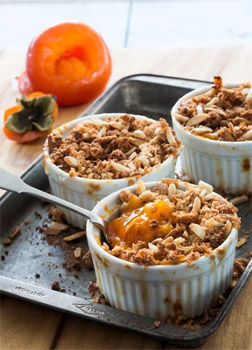Persimmon and Amaretti Crumble with Mascarpone and Aged Balsamic

Persimmon and Amaretti Crumble with Mascarpone and Aged Balsamic
Eat with the seasons and celebrate the arrival of autumn with these simple yet impressive persimmon recipes, perfect for entertaining with ease.
Not only are persimmons a fantastic snack all by themselves thanks to a subtle, sweet flavour and tantalising texture, but they also add a wonderful nutritious boost to sweet and savoury dishes. Persimmons are loaded almost twice the dietary fibre of an apple and hold higher levels of many minerals and antioxidants.
Aussie persimmons spring to life from orchards across Australia from the end of February until mid-June, signalling the return of one of Australia's best kept secrets.
Serves 4
Ingredients
4 sweet persimmons, peeled, diced in 2cm cubes OR scooped flesh of 4 original persimmons
50g butter, cut into 4 equal portions
1/4 cup slivered almonds
100g amaretti biscuits, roughly crushed by hand
125g mascarpone OR double cream
1 tsp full icing sugar
1/2 tsp vanilla bean paste
1 Tbs aged balsamic OR balsamic reduction*
*To make the balsamic reduction, combine 1/2 cupbalsamic vinegar and 1/2 cup of caster sugar in a small saucepan. Bring to boil, reduce heat and simmer until sugar has melted and the balsamic is slightly syrupy.
Method
Preheat oven to 180ºC.
Meanwhile mix the mascarpone with the icing sugar and vanilla until combined. Place a dollop over each ramekin, then a zig zag drizzle of the balsamic over the top. Serve immediately.
Australian Persimmons
Varieties
Sweet Persimmons (non-astringent)
Sweet persimmons are the most commonly found variety and account for nearly 95% of production.
Round in shape with a diameter of around 10cm. The fruit has a slightly flattened top that holds the green stem (calyx) and ranges in colour from pale orange to a deep red-orange.
Best eaten crunchy and firm like an apple but can be left till mushy and soft, like the original persimmon.
Has a refreshingly sweet and mild flavour.
Original Persimmons (astringent)
Large, heart shaped fruits, ranging in colour from pale orange to deep red-orange.
Needs to be harvested once fully mature.
Ready for eating when the flesh is soft, jelly-like and sweet. If you taste astringency you need to allow the fruit to ripen further.
Health Benefits
Good source of vitamin C and beta carotene, high in fibre and fat free.
A sweet persimmon contains almost twice the dietary fibre of an apple and higher levels of many minerals and antioxidants.
Selecting and Storing
When it comes to persimmons, there is no one colour to look for. Fruit can range in shade from a pale orange to a deep red-orange, depending upon variety and stage of the season.
Despite being firm to the touch, handle persimmons with care as the thin skin is delicate and bruises easily.
Most persimmons will have small blemishes on their surface, but this will not affect the crisp exciting flesh inside.
Choose sweet persimmons that still have green, semi-pliable caps.
Put the persimmon in a paper bag with a couple of bananas to speed up the ripening process.
Persimmons will keep out of the fridge for up to five days.
How to Cut
The star method: hold the persimmon on the side and cut across and you will see the star in side.
The apple method: cut out the core (calyx) and quarter.
To view celebrity cook Poh Ling Yeow's cutting demonstrations visit our YouTube account here.
How to Use
As part of a cheese plate. Cut persimmons using the star method.
In a salad. Toss thin slices of persimmons through salad leaves and top with shavings of parmesan, toasted almonds, a drizzle of olive oil and balsamic.
As a snack. Cut, quarter like an apple, or serve with yoghurt and nuts.
For serving suggestions visit the Persimmons Australia here.
Seasonality & Production
Persimmons are in season from late February to mid June (Autumn to Winter) and are available in supermarkets, and all good fruit stores.
Queensland is the major producing state but harvesting also occurs in coastal NSW, the Goulburn and Murray valleys in VIC and SA as well as south west WA.
Southern Queensland accounts for 50% of production.
Commercial production of original persimmons is generally confined to regions around Sydney and in Victoria.
Australia produces less than 1 per cent of world production. However, production is on the rise here with new plantings in New South Wales and Victoria driving industry growth.
Sweet persimmons (non-astringent) were introduced to Australia in the late 1970s and now comprise of nearly 90 per cent of local production.
Persimmons Australia has now gone social! Join the conversation on Facebook and Instagram.
Instagram: @persimmonsaustralia #persimmons #perfectpersimmons
Facebook: www.facebook.com/persimmonsaustralia
YouTube: www.youtube.com/persimmonsaustralia
Website: www.persimmonsaustralia.com.au
Persimmon Recipes by Poh Ling Yeow
MORE



